# Datenbankbasierte Web-Anwendungen ## Foreign Keys und Datenabfragen ### Medieninformatik SoSe 2017 Renzo Kottmann <a rel="license" href="http://creativecommons.org/licenses/by-nc/4.0/"><img alt="Creative Commons License" style="border-width:0" src="https://i.creativecommons.org/l/by-nc/4.0/88x31.png" /></a><br />This work is licensed under a <a rel="license" href="http://creativecommons.org/licenses/by-nc/4.0/">Creative Commons Attribution-NonCommercial 4.0 International License</a>. --- # Zusammenfassung der vorherigen Vorlesung * Eigene Datentypen * Foreign Keys bei Aufzaehlungen (technisch) Nicht besprochen: * Umsetzung von ERM Beziehungen mittels Foreign Keys --- # Aktuelle Implementierung * [SQL file mit ersten Testdaten](/lecture/2017-03/database-mi/mi-db-vorlesung-5.sql) --- # Relationships (Beziehungen) revisited Verschiedene Entitäten können zueinander in Beziehung gesetzt werden. * In jeder Beziehung haben Entitäten gewisse Rollen * Beziehungen können Eigenschaften (Attribute) haben * Beziehungen haben Kardinalitäten --- # Beziehungen * Teilenhmer ist in einer Projektgruppe und einer Laborgruppe * Jede Projektgruppe bearbeitet mehere Laboruebungen 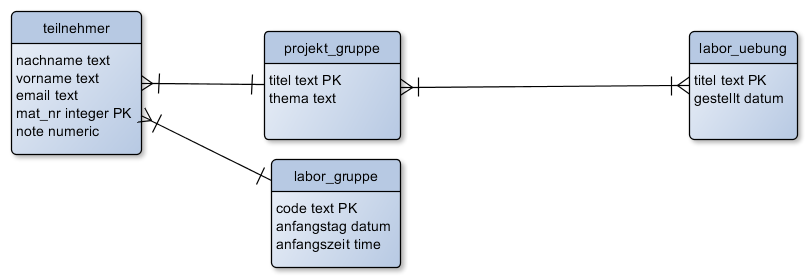 --- # Beziehungen mit Foreign Keys * Bestimmem die * Attribute welche die Beziehungen identifizieren * Kardinalitäten  --- class: split-40 # Foreign Keys (one to many) .column[ * Koennen nur eins zu viele Beziehungen umsetzen * Werden immer von viele zu eins gesetzt ] .column[ ```sql CREATE TABLE labor_gruppe ( code text PRIMARY KEY CHECK ( code IN ('w','x','y','z') ) , -- Attribute fehlen anfangszeit time NOT NULL ); CREATE TABLE teilnehmer ( vorname text CHECK ( vorname != '' ), nachname text, CHECK ( vorname != '' ), matrikel_nr integer PRIMARY KEY, -- Attribute fehlen labor text REFERENCES labor_gruppe(code), geschlecht text REFERENCES geschlecht(name) ON UPDATE CASCADE ); ``` ] --- class: split-40 # Foreign Keys (one to many) .column[ # Frage Wird hier `0..1 zu N` oder `1 zu N` umgesetzt? ] .column[ ```sql CREATE TABLE labor_gruppe ( code text PRIMARY KEY CHECK ( code IN ('w','x','y','z') ) , -- Attribute fehlen anfangszeit time NOT NULL ); CREATE TABLE teilnehmer ( vorname text CHECK ( vorname != '' ), nachname text, CHECK ( vorname != '' ), matrikel_nr integer PRIMARY KEY, -- Attribute fehlen labor text REFERENCES labor_gruppe(code), geschlecht text REFERENCES geschlecht(name) ON UPDATE CASCADE ); ``` ] --- # Foreign Keys (many to many)  --- # Foreign Keys (many to many) * Umsetzung durch neue "Beziehungs"-Relation  --- class: split-40 # Foreign Keys (many to many) .column[ * Neue Tabelle, die auf die beiden existierenden referenziert * Primary Key der neuen Tabelle ist Kombination der PKs der existierenden Tabellen ] .column[ ```sql CREATE TABLE projekt_gruppe ( titel text PRIMARY KEY CHECK ( titel != '' ) , thema text NOT NULL DEFAULT '' ); CREATE TABLE labor_uebung ( titel text PRIMARY KEY, gestellt date NOT NULL UNIQUE ); CREATE TABLE labor_abgabe ( gruppe text REFERENCES projekt_gruppe(titel), uebung text REFERENCES labor_uebung(titel), PRIMARY KEY (gruppe,uebung) ); ``` ] --- class: center, middle # Von Anfragen zu Abfragen --- # Anfragen Z.b. Wieviel Teilnehmer sind in meinem Kurs? --- # Staerken relationaler Datenbanken: 1. Persistente, sichere und strukturierte Datenspeicherung 1. Effiziente **Abfragen** um Anfragen beantworten zu koennen! -- * SQL hat nur einen Befehl dafuer: -- # **`SELECT`** --- # Anatomy von SELECT ~~~sql SELECT * -- welche Spalten sollen wie angezeigt werden FROM tabelle -- Daten welcher Tabelle WHERE true -- Selektionesbedingungen: nur Daten, die Kriterium entsprechen ~~~ -- Kann gelesen werden als: Zeige mir alle Spalten der Tabelle "tabelle" an und davon alle Zeilen. -- Datenbank interpretiert das in der Reihenfolge `FROM`, `WHERE`, `'*'` (Spalten) Hole aus der Tabelle "tabelle" alle Zeilen die der Bedingung 'true' entsprechen und zeige davon alle Spalten an. --- # Konkretes SELECT ~~~sql SELECT * -- * (asterisk) heisst alle spalten, wie sie sind FROM "teilnehmer"; -- Daten der Tabelle mit dem Namen "order" ~~~ Boolsche `WHERE` Bedingung kann weggelassen werden, wenn man alle Zeilen will. --- # Sammeln von Anfragen --- # Transaktion Eine Transkation ist eine Menge von Operationen die atomic, consistent, isoliert und dauerhaft sind (ACID). --- # ACID * __A__lle Aenderungen mit __C__hirurgischer integritaet in einem __I__soliertem Vorgang zusammengefasst und mit __D__auerhaftem Ergebnis. --- Die wichtigsten Eigenschaften im Einzelnen: * Atomic Eine Transaktion gruppiert mehrere Anweisungen in eine einzige atomare Operation in der "Alles oder Nichts” stattfindet. * Consistent Eine Transaktion bringt eine Datenbank von einem konsistenten Zustand in den nächsten. * Isolated Transaktion ist unabhängig, d.h. sie wird nicht durch konkurrierende Transaktionen beeinflusst. * Durable Bei der erfolgreichen Beendigung einer Transaktion sind alle Änderungen dauerhaft gespeichert. --- # Konsistenz bei sehr vielen gleichzeitigen Aenderungen * Transaktionen garantieren, dass trotz gleichzeitiger Aenderungen von vielen verschiedenen Benuztern, alle Aenderungen konsistent sind. * Tatsaechlich ist jede einzelne SQL-Anweisung bei den meisten Datenbank implizit eine einzelne Transaktion, d.h. eine Gruppe von Anweisungen mit nur einer Anweisung --- # Transaktion mit meheren Anweisungen [PostgreSQL Documentation fuer syntaktische Details und fortgeschrittene Eigenschaften](https://www.postgresql.org/docs/9.3/static/sql-begin.html) Ausgangslage: Datenbank ist in einem super gutem Zustand: Z1 ```sql -- Transaktion wird angefangen: BEGIN; SQL Anweisung 1; SQL Anweisung 2; ... SQL Anweisung N; -- Bleibt offen bis: COMMIT; ``` Wenn Transaktion __gut laeuft__, d.h. alle Anweisungen korrekt sind: Datenbank ist in einem super gutem Zustand: Z2 Wenn Transaktion __fehlschlaegt__, d.h. nur eine der Anweisungen zum Fehler fuehrt: Datenbank wird in den vorherigen Zustand zurueck gesetzt (rollback): Z1 [PostgreSQL Documentation fuer syntaktische Details und fortgeschrittene Eigenschaften](https://www.postgresql.org/docs/9.3/static/sql-begin.html) --- # Gewollter Transaktionsabbruch ```sql -- Transaktion wird angefangen: BEGIN; SQL Anweisung 1; SQL Anweisung 2; ... SQL Anweisung N; -- Bleibt offen bis: ROLLBACK; ``` Wenn Transaktion __fehlschlaegt__ oder __erfolgreich__ ist: Datenbank wird in den vorherigen Zustand zurueck gesetzt (rollback): Z1 --- # DDL Entwicklung * PostgreSQL ist einer der wenigen DBMS, die auch DDL Anweisungen in Transaktionen ausfuehren kann ```sql -- Transaktion wird angefangen: BEGIN; CREATE TABLE test (id integer PRIMARY KEY); INSERT INTO test VALUES (1),(2),(3); SELECT * from test; UPDATE test SET id = id + 3; SELECT * from test; ROLLBACK; ``` * Sehr nuetzlich fuer iterative, evolutionaere Datenbankentwicklung --- --- class: middle, center # Danke für die Zusammenarbeit --- class: middle, center # Anhang --- # Abfragen ueber mehere Tabellen --- # Revisited: Anatomy von SELECT ~~~sql SELECT * -- welche Spalten sollen wie angezeigt werden FROM tabelle -- Daten welcher Tabelle WHERE true -- Selektionesbedingungen: nur Daten, die Kriterium entsprechen ~~~ Kann gelesen werden als: Zeige mir alle Spalten der Tabelle "tabelle" an und davon alle Zeilen. -- Es wird immer eine und nur eine Tabelle durch `SELECT` erzeugt, daher ist das technisch praeziser: Erzeuge und zeig mir eine virtuelle Tabelle, die folgender Anweisung enpricht: Zeige alle Spalten der Tabelle "tabelle" an und davon alle Zeilen. --- # Beispiel-Tabellen ~~~ TabelleA TabelleB id name id name -- ---- -- ---- 1 Pirate 1 Rutabaga 2 Monkey 2 Pirate 3 Ninja 3 Darth Vader 4 Spaghetti 4 Ninja ~~~ --- class: split-50 # INNER JOIN .column[ ~~~sql SELECT * FROM TabelleA AS a INNER JOIN TabelleB as b ON a.name = b.name ~~~ ~~~ id name id name -- ---- -- ---- 1 Pirate 2 Pirate 3 Ninja 4 Ninja ~~~ ] .column[  ] --- class: split-50 # FULL OUTER JOIN .column[ ~~~sql SELECT * FROM TabelleA as a FULL OUTER JOIN TabelleB as b ON a.name = b.name ~~~ ~~~ id name id name -- ---- -- ---- 1 Pirate 2 Pirate 2 Monkey null null 3 Ninja 4 Ninja 4 Spaghetti null null null null 1 Rutabaga null null 3 Darth Vader ~~~ ] .column[  ] --- class:split-50 # LEFT OUTER JOIN .column[ ~~~sql SELECT * FROM TabelleA AS a LEFT OUTER JOIN TabelleB AS b ON a.name = b.name ~~~ ~~~ id name id name -- ---- -- ---- 1 Pirate 2 Pirate 2 Monkey null null 3 Ninja 4 Ninja 4 Spaghetti null null ~~~ ] .column[ 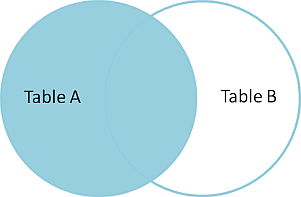 ] --- class:split-50 # LEFT OUTER JOIN: nur Zeilen von TabelleA .column[ ~~~sql SELECT * FROM TabelleA AS a LEFT OUTER JOIN TabelleB AS b ON a.name = b.name WHERE b.id IS null ~~~ ~~~ id name id name -- ---- -- ---- 2 Monkey null null 4 Spaghetti null null ~~~ ] .column[ 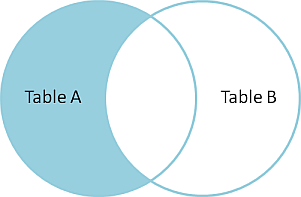 ] --- class:split-50 # FULL OUTER JOIN: nur exklusive Zeilen .column[ ~~~sql SELECT * FROM TabelleA AS a FULL OUTER JOIN TabelleB AS b ON a.name = b.name WHERE a.id IS null OR b.id IS null ~~~ ~~~ id name id name -- ---- -- ---- 2 Monkey null null 4 Spaghetti null null null null 1 Rutabaga null null 3 Darth Vader ~~~ ] .column[ 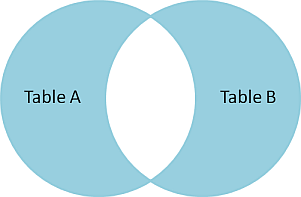 ] --- class:split-50 # CROSS JOIN: Erzeugt kartesiches Produkt .column[ ~~~sql SELECT * FROM TabelleA CROSS JOIN TabelleB ~~~ ] .column[ 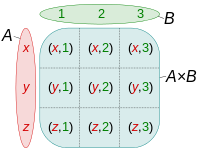 ] In einfachen Worten: Verbindet jede Zeile der TabelleA mit jeder Zeile der TabelleB --- 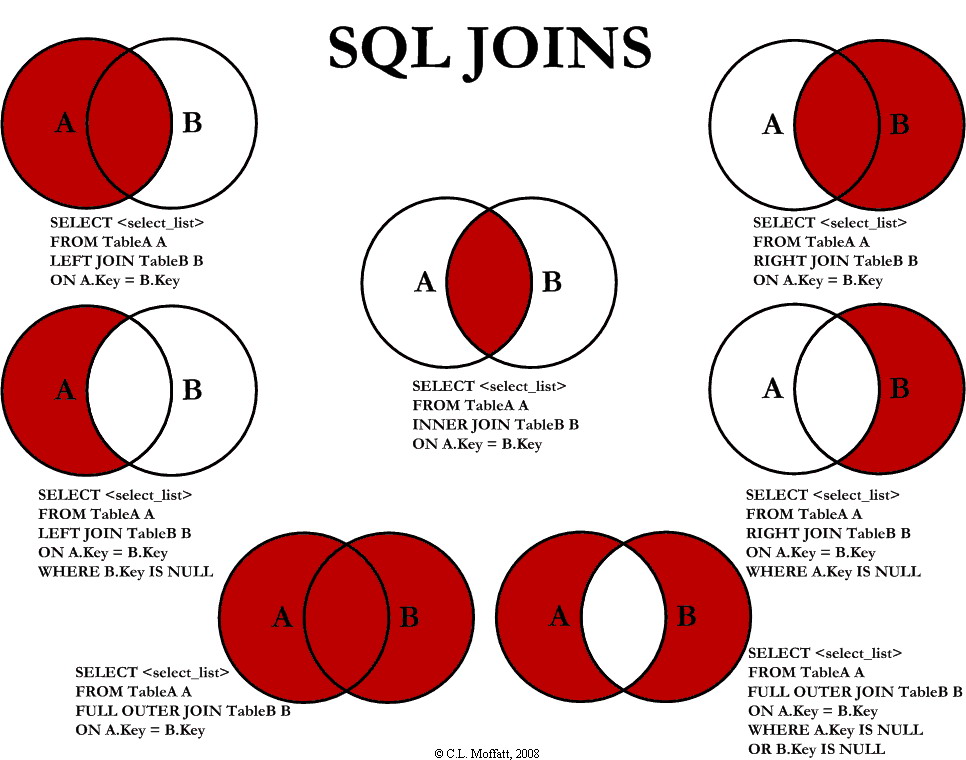 --- # Diskussion zu Visualisierung von SQL-joins * [Original Artikel mit Venn-Overview](http://www.codeproject.com/Articles/33052/Visual-Representation-of-SQL-Joins) * [Diskussion und alternative Darstellung](http://stackoverflow.com/questions/13997365/sql-joins-as-venn-diagram) * [Kategorisierung nach JOIN-Typen](www.way2tutorial.com/sql/sql_join_types_visual_venn_diagram.php) --- class: center,middle # Normalisierung --- # Meine Vorgehensweise * Alles was, gemaess den Anforderungen, eigenstaendig und unabhängig von exisitereneden Entitaeten gemanaged werden muss, ist eine neue eigenstaendige Entitaet. * Managen heisst: Alles was zu unterschiedlichen Zeiten erst ins System kommt und eigene insert, update, und delete Regeln hat. --- # Appendix Mother Celko's Thirteen Normalization Heuristics 1. Does the table model either a set of one and only one kind of entity or one and only one relationship. This is what I call disallowing a “Automobiles, Squids and Lady GaGa” table. Following this rule will prevent ‘Multi-valued dependencies’ (MVD) problems and it is the basis for the other heuristics. 2. Does the entity table make sense? Can you express the idea of the table in a simple collective or plural noun? To be is to be something in particular; to be everything in general or nothing in particular is to be nothing at all (this is known as the Law of Identity in Greek logic). This is why EAV does not work – it is everything and anything. 3. Do you have all the attributes that describe the thing in the table? In each row? The most important leg on a three-legged stool is the leg that is missing. --- 4. Are all the columns scalar? Or is a column serving more than one purpose? Did you actually put hat size and shoe size in one column? Or store a CSV list in it? 5. Do not store computed values, such as (unit_price * order_qty). You can compute these things in VIEWs or computed columns. 6. Does the relationship table make sense? Can you express the idea of the table in a simple sentence, or even better, a name for the relationship? The relationship is “marriage” and not “person_person_legal_thing” 7. Did you check to see if the relationship is 1:1, 1:m or n:m? Does the relationship have attributes of its own? A marriage has a date and a license number that does not belong to either of the people involved. This is why we don't mind tables that model 1:1 relationships. --- 8. Does the entity or relationship have a natural key? If it does, then you absolutely have to model it as the PRIMARY KEY or a UNIQUE constraint. Is there a standard industry identifier for it? Let someone else do all that work for you. 9. If you have a lot of NULL-able columns, the table is probably not normalized. 10. The NULLs could be non-related entities or relationships. 11. Do the NULLs have one and only one meaning in each column? 12. If you have to change more than one row to update, insert or delete a simple fact, then the table is not normalized. 13. Did you confuse attributes, entities and values? Would you split the Personnel table into “Male_Personnel” and ”Female_Personnel” by splitting out the sex code? No, sex is an attribute and not an entity. Would you have a column for each shoe size? No, a shoe size is a value and not an attribute.